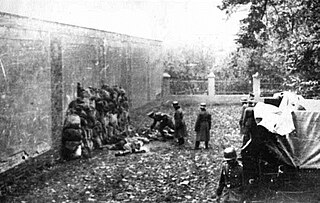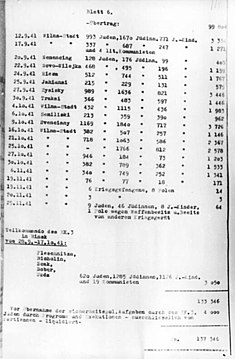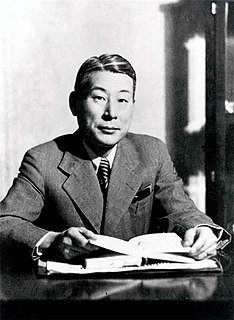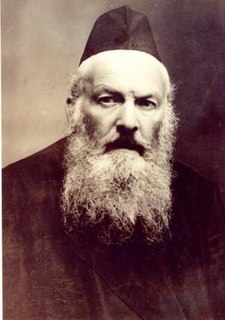 W
WThe Holocaust in Lithuania resulted in the near total destruction of Lithuanian (Litvaks) and Polish Jews, living in Generalbezirk Litauen of Reichskommissariat Ostland within the Nazi-controlled Lithuanian SSR. Out of approximately 208,000–210,000 Jews, an estimated 190,000–195,000 were murdered before the end of World War II, most between June and December 1941. More than 95% of Lithuania's Jewish population was massacred over the three-year German occupation—a more complete destruction than befell any other country affected by the Holocaust. Historians attribute this to the massive collaboration in the genocide by the non-Jewish local paramilitaries, though the reasons for this collaboration are still debated. The Holocaust resulted in the largest-ever loss of life in so short a period of time in the history of Lithuania.
 W
WThe Blue Police, was the police during the Second World War in German-occupied Poland. The entity's official German name was Polnische Polizei im Generalgouvernement.
 W
WEinsatzgruppen were Schutzstaffel (SS) paramilitary death squads of Nazi Germany that were responsible for mass killings, primarily by shooting, during World War II (1939–1945) in German-occupied Europe. The Einsatzgruppen had an integral role in the implementation of the so-called "Final Solution to the Jewish Question" in territories conquered by Nazi Germany, and were involved in the murder of much of the intelligentsia and cultural elite of Poland, including members of the Catholic priesthood. Almost all of the people they killed were civilians, beginning with the intelligentsia and swiftly progressing to Soviet political commissars, Jews, and Romani people, as well as actual or alleged partisans throughout Eastern Europe.
 W
WThe Einsatzgruppen Operational Situation Reports (OSRs), or ERM for the German: Die Ereignismeldung UdSSR, were dispatches of the Nazi death squads (Einsatzgruppen), which documented the progress of the Holocaust behind the German-Soviet frontier in the course of Operation Barbarossa, during World War II. The extant reports were sent between June 1941 and April 1942 to the Chief of the Security Police and the SD in Berlin, from the occupied eastern territories including modern-day Poland, Belarus, Ukraine, Russia, Moldova, and the Baltic Countries. During the Nuremberg War Crimes Trials the originals were grouped according to year and month and catalogued using a consecutive numbering system, as listed in the below table. The original photostats are held at the National Archives in Washington D.C..
 W
WDuring World War II, the Nazi German Einsatzkommandos were a sub-group of the Einsatzgruppen – up to 3,000 men total – usually composed of 500–1,000 functionaries of the SS and Gestapo, whose mission was to exterminate Jews, Polish intellectuals, Romani, and communists in the captured territories often far behind the advancing German front. Einsatzkommandos, along with Sonderkommandos, were responsible for the systematic killing of Jews during the aftermath of Operation Barbarossa, the invasion of the Soviet Union. After the war several commanders were tried in the Einsatzgruppen trial, convicted, and executed.
 W
WThe Fareynikte Partizaner Organizatsye was a Jewish resistance organization based in the Vilna Ghetto that organized armed resistance against the Nazis during World War II. The clandestine organisation was established by Communist and Zionist partisans. Their leaders were writer Abba Kovner, Josef Glazman and Yitzhak Wittenberg.
 W
WThe Generalplan Ost, abbreviated GPO, was the Nazi German government's plan for the genocide and ethnic cleansing on a vast scale, and colonization of Central and Eastern Europe by Germans. It was to be undertaken in territories occupied by Germany during World War II. The plan was attempted during the war, resulting indirectly and directly in the deaths of millions by shootings, starvation, disease, extermination through labor, and genocide. But its full implementation was not considered practicable during the major military operations, and was prevented by Germany's defeat.
 W
WThe so-called Jäger Report, also Jaeger Report was written on 1 December 1941 by Karl Jäger, commander of Einsatzkommando 3, a killing unit of Einsatzgruppe A which was attached to Army Group North during the Operation Barbarossa. It is the most detailed and precise surviving chronicle of the activities of one individual Einsatzkommando, and a key record documenting the Holocaust in Lithuania as well as in Latvia and Belarus.
 W
WKauen was a Nazi concentration camp located in the former Kovno Ghetto. It operated from 15 September 1943 to 14 July 1944 and had eight satellite camps located around the city of Kaunas, in modern-day Lithuania. Most prisoners were Jews who had survived the previous years of the Holocaust in Lithuania. The main camp was liberated by the Red Army on 1 August 1944.
 W
WIser Lubotzky (Lubocki) was a member of Betar, the Vilna-ghetto's underground and a partisan fighter. He was both a fighting member and a commander of the Irgun, serving as a national recruiting officer and heading the Ramat Gan group. As a lawyer, he served as the head of Herut’s lawcourt and as the Likud's first legal adviser.
 W
WSonderaktion 1005, also called Aktion 1005, or Enterdungsaktion, began in May 1942 during World War II to hide any evidence that people had been murdered by Nazi Germany in German-occupied Poland and Soviet Union. The project, which was conducted in secrecy from 1942 to 1944, focused on concealing evidence of mass murder at the Operation Reinhard killing centres, as well as at other sites. Groups of Sonderkommando prisoners, officially called Leichenkommandos, were used to exhume mass graves and burn the bodies; inmates were often put in chains to prevent them from escaping.
 W
WChiune Sugihara was a Japanese diplomat who served as vice-consul for the Japanese Empire in Kaunas, Lithuania. During the Second World War, Sugihara helped thousands of Jews flee Europe by issuing transit visas to them so that they could travel through Japanese territory, risking his job and the lives of his family. The fleeing Jews were refugees from German-occupied Western Poland and Soviet-occupied Eastern Poland, as well as residents of Lithuania. In 1985, the State of Israel honored Sugihara as one of the Righteous Among the Nations for his actions. He is the only Japanese national to have been so honored. The year 2020 was "The Year of Chiune Sugihara" in Lithuania. It has been estimated as many as 100,000 people alive today are the descendants of the recipients of Sugihara visas.
 W
WTelshe Yeshiva is a yeshiva in Wickliffe, Ohio, formerly located in Telšiai, Lithuania. It is a prominent Haredi institution of Torah study, with additional branches in Chicago and New York.
 W
WThe Virginia Holocaust Museum (VHM) is a public history museum located in Richmond, Virginia, United States. The museum is dedicated to depicting the Holocaust through the personal stories of its victims.
 W
WElchonon Bunim Wasserman was a prominent rabbi and rosh yeshiva (dean) in prewar Europe. He was one of the closest students of Rabbi Yisrael Meir Kagan and a noted Talmid Chacham. In the interwar period, he served as rosh yeshiva of Yeshiva Ohel Torah-Baranovich.
 W
WYeshivas Knesses Yisrael was a yeshiva located in the Lithuanian town of Slabodka (Vilijampolė), adjacent to Kovno (Kaunas). It was known colloquially as the "mother of yeshivas" and was devoted to high-level study of the Talmud. It functioned from the late 19th century until World War II.
 W
WJan Zwartendijk was a Dutch businessman and diplomat. As director of the Philips plants in Lithuania and part-time acting consul of the Dutch government-in-exile, he supervised the writing of 2,345 visas for Curaçao to save Jews from the Holocaust during World War II. In 1997, Yad Vashem recognised him as Righteous Among the Nations.